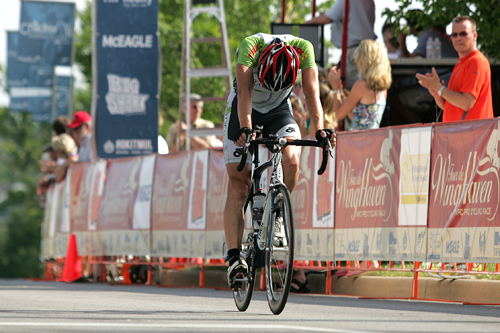Lactate, your body’s buffering agent, neutralizes the acid that builds up in your legs and makes them burn during heavy exertion. The harder you turn the cranks, the faster acid accumulates. Eventually, your muscles generate more acid than you can neutralize and your searing muscles force you to ease up. The point at which you begin to accumulate acid more quickly than you can dissipate it is your LT, or, in riding terms, the fastest pace you can maintain for 30 minutes without feeling like your legs are on fire.
HOW TO FIND YOUR LACTATE THRESHOLD
Most likely, you won’t find yourself hangin’ with the pros in a lab, where they pedal against ever-increasing resistance while technicians take blood samples to measure the increasing lactate levels. But you can find your LT with a do-it-yourself time trial.
Map a 3-mile route that you can ride without stopping. Strap on a heart rate monitor, warm up for 20 minutes, then ride the route at the fastest pace you can sustain. Recover for 10-20 minutes (ride back to the start of your route at an easy pace). Repeat the test. Your LT is approximately the average heart rate of the two efforts. (More accurately, it’s 103 percent of that figure.) Jot down your times and average paces; repeat the test in eight weeks to see your progress.
HOW TO RAISE YOUR LACTATE THRESHOLD
Like most things body-related, LT is partially genetic, but it’s also quite trainable. By systematically pushing your limits, you can help your body become more efficient at clearing and buffering lactic acid. The trick is riding that razor-thin edge between the point where you can ride comfortably for hours and where you can sustain only a few minutes before frying. It’s important that you have plenty of base miles and some speedwork under your belt before you start LT training. The bigger your aerobic engine when you begin, the better your results will be. The following drills are designed to raise your LT. Choose one drill per workout, and do LT training no more than two days a week, preferably not on consecutive days.
STEADY STATE INTERVALS
After a good warm-up, ride 10 minutes at a steady effort, keeping your heart rate three to five beats below your LT heart rate. Recover for 10 minutes, then repeat two more times. Once you’re comfortable at this level, do two 20-minute steady-state efforts, recovering for 20 minutes between. Eventually, work up to one 30-minute effort. This is the most effective way to increase power at LT.
UP AND DOWN INTERVALS
These intervals blend LT and VO2 max (your body’s ability to process oxygen) training to simulate the effort you need when racing on a hilly course, where you have to push beyond your lactate threshold for short surges then clear the acid and recover quickly. First, warm up. Then pick up the pace to your LT heart rate and hold that intensity for five minutes. Push it to about three to five beats above LT for one to two minutes, then drop it back down to LT. Continue for a total of three cycles, or about 18 to 20 minutes.
TOLERANCE LEVELS
Crit and mountain bike racers need to elevate their ST (suffering threshold) as well as their LT, because those situations demand pushing past LT and holding it there for extended bursts over and over. By training at an intensity where your body can’t clear the lactate, you’ll boost your ability to keep riding hard in the face of high lactate levels. After a thorough warm-up, increase your effort to about five beats above your LT heart rate. Hold it there for two to three minutes. Reduce your effort for 60 to 90 seconds, just long enough so you feel partially recovered, but not quite ready to go again. Repeat three times.
by Ian Jenner

